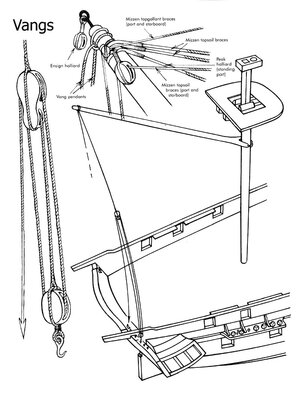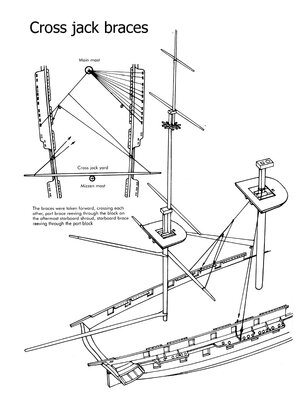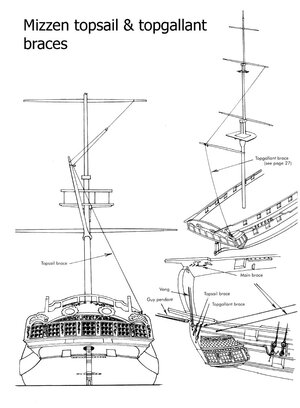Is there a specified gaff angle? Most pics I see have them at about 45 degrees but every so often I see one steeper than that. can't seem to find anything in my books.
-
LUCZORAMA SHIPWRECK SCAVENGER HUNT GIVEAWAY. 4 Weeks of Fun • 1 Legendary Prize ((OcCre’s Fram Ship)) • Global Crew Welcome!
**VIEW THREAD HERE**
You are using an out of date browser. It may not display this or other websites correctly.
You should upgrade or use an alternative browser.
You should upgrade or use an alternative browser.
It can be altered by the rigging to get the best power from the sails.
In his book "Gaff Rig," John Leather writes that the gaff should be at an angle of 30 degrees to the centerline of the mast. He further states that if a gaff topsail is to be carried, the the angle should be 42 degrees. Note that Leather is addressing small craft no older than the 18th century. In practice, as with so many aspects of rigging, there may be significant differences among types of craft, locales, and individual sailmakers and bosuns. As mentioned by Corsair in post #2, the drive of a gaff sail in any particular wind speed and point of sailing can be optimized by adjusting the throat halliard and the peak halliard. These adjustments are relatively small in relation to the basic setup of the sail. For modeling purposes, it's best to do as much research as practical on the ship in question to make the best guess on such rig details. Have fun!
If you're building a model of a ship that existed, it's probably best to go what's shown on the sail-plan rather than make something up.
Square rigged vessels, into the late 1700s often peaked their gaffs lower because the mizzen braces ran to the peak of the gaff. If the gaff's peaked too high, you don't get the required leverage on the braces.
Square rigged vessels, into the late 1700s often peaked their gaffs lower because the mizzen braces ran to the peak of the gaff. If the gaff's peaked too high, you don't get the required leverage on the braces.
I agree with the first sentence unless there are reliable references indicating otherwise. Plans in kits aren't always based on the best research. I've seen examples of mizzen topsail braces running aft to the peak of a lateen yard but I don't recall that arrangement on a gaff spanker. The mizzen braces typically run forward. Do you have any examples of the braces running to a gaff?If you're building a model of a ship that existed, it's probably best to go what's shown on the sail-plan rather than make something up.
Square rigged vessels, into the late 1700s often peaked their gaffs lower because the mizzen braces ran to the peak of the gaff. If the gaff's peaked too high, you don't get the required leverage on the braces.
Fair winds!
Andy,I agree with the first sentence unless there are reliable references indicating otherwise. Plans in kits aren't always based on the best research. I've seen examples of mizzen topsail braces running aft to the peak of a lateen yard but I don't recall that arrangement on a gaff spanker. The mizzen braces typically run forward. Do you have any examples of the braces running to a gaff?
Fair winds!
In the book "Historic Ship Models" by Wolfram zuMondfeld, in the section on Gaff Sails on page 325, the image appears to show the mizzen topsail yard braces as well as the mizzen topgallant yard braces going to the peak of the gaff. I know this is a book and not documented "reliable references" proof and that books have been wrong in the past, but it appears as though it is possible. This was only the very first book I looked in.
In the second book I reviewed, "Anatomy of the Ship" for the Bounty" by John McKay, on pages 100 and 101, it appears to show a similar arrangement. I'm not saying this is documented proof, but it seems it is certainly possible.
Thanks,
Jeff
James Lees says; "...up to 1805, [braces] led aft with the standing part made fast to the peak of the mizzen yard (lateen) or gaff, the running part rove through the brace pendant blocks, back through single blocks on a span round the mizzen yard or gaff, just below the standing part, and the brace led down to the rails by the transom....from 1805to 1815 the standing part of the brace was seized to the main mast head..." (Masting & Rigging page 94)The mizzen braces typically run forward. Do you have any examples of the braces running to a gaff?
A painting of the boat in question from his build log shows this, and many other paintings, like this Hunt painting...

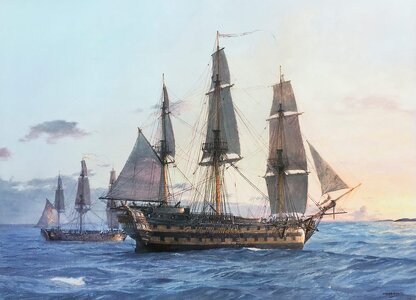
and a contemporary painting.
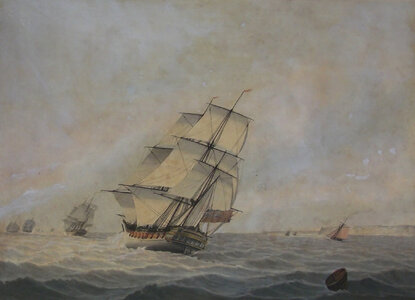
I don't understand it, or why they would run things that way. I kept seeing it in works by Gardner, Dawson, and others and writing it off as artist whim, or lack of knowledge, like modelers that put crows-feet on everything, or USS in front of every thing they write; but it apparently was done, and I had to learn to accept it.
Markwart in his book gives the following figures about the angle of the gaff: 40°-45°.
Thanks guys. I haven't got to the braces yet but I'll keep my eyes open when I do.
I have the Kindle version of Petersson. It's a pain but it works. I have, I think. five rigging books. Sometimes all of them are different so you just have to pick the most convenient for your situation. I've often thought that maybe just one rigging book would be the answer but then they all leave out some stuff too. 
Even different builders in the same nation at the same time period would sometimes do things differently, so when you add different nations and different time periods, a single book to cover it all would be a gargantuan undertaking!I have the Kindle version of Petersson. It's a pain but it works. I have, I think. five rigging books. Sometimes all of them are different so you just have to pick the most convenient for your situation. I've often thought that maybe just one rigging book would be the answer but then they all leave out some stuff too.
One thing they all seem to be missing is an explanation of what the different parts of the rigging do. They all do a good job of saying that this goes from here to there but nothing on what it does.
Phil Bolger, the extraordinary boat designer, described his design of the replica of the HMS Rose (1751) in his book "30-Odd Boats." About running rigging, he writes "The running rigging of square-riggers always tended to be changed around with every change of masters. There's a wide choice of unsatisfactory leads, some worse than others. To the best of my knowledge, there's no good way of doing it." The chapter also includes useful sketches of standing and running rigging along with descriptions of each line. The new Rose was launchedin 1970. In 2001 she was modified to portray the HMS Surprise in the movie "Master and Commander: the Far Side of the World." I trust that you all have seen the movie as well as read the entire Aubrey/Maturin series of books by Patrick O'Brian. Which reminds me that Jack Aubrey went on about rigging modifications, especially crosscatharpins, in several of the books.Even different builders in the same nation at the same time period would sometimes do things differently, so when you add different nations and different time periods, a single book to cover it all would be a gargantuan undertaking!
Fair winds!





